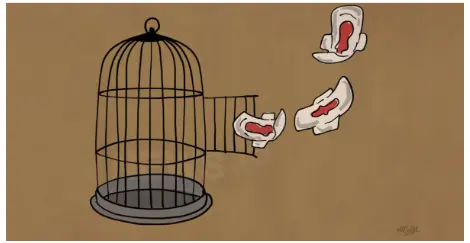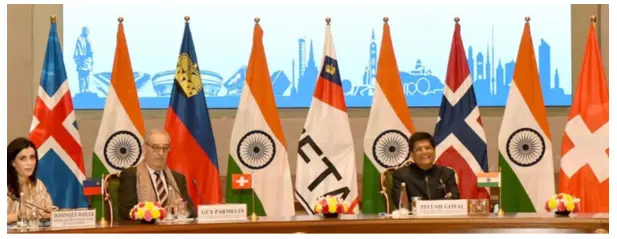Saturday, 1st June 2024
PRAGATI-2024
In News: The Central Council for Research in Ayurvedic Sciences (CCRAS), an autonomous body under the Union Ministry of Ayush, launched “PRAGATI-2024”.
PRAGATI-2024: Pharma Research in AyurGyan and Techno Innovation
PRAGATI-2024 aims to explore research opportunities and foster collaboration between the Central Council for Research in Ayurvedic Sciences (CCRAS) and the Ayurveda drug industry.
- About CCRAS
- The Central Council for Research in Ayurvedic Sciences (CCRAS) is an autonomous body under the Ministry of AYUSH, Government of India.
- It serves as the apex body in India for undertaking, coordinating, formulating, developing, and promoting research in Ayurvedic sciences on scientific lines.
- Research Activities
- CCRAS conducts various research activities, including:
- Medicinal Plant Research, which encompasses Medico-Ethno Botanical Survey, Pharmacognosy, and Tissue Culture.
- Drug Standardization.
- Pharmacological Research.
- Clinical Research.
- Literary Research and Documentation.
- Tribal Health Care Research Programme.
- Additional Roles
- The council also formulates, coordinates, develops, and promotes research in Ayurveda and the Sowa-Rigpa systems of medicine.
- Headquarters
- CCRAS is headquartered in New Delhi.
Source: PIB
RBI annual report 2023-24
Context:
- The Reserve Bank of India's (RBI) Annual Report for the year 2023-24, provides a comprehensive review of the Indian economy's performance, the central bank's policy measures, and its future outlook.
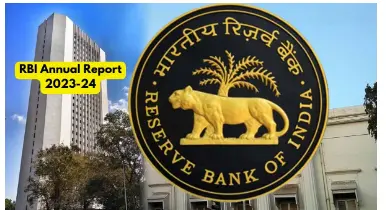
Key Insights from the RBI Annual Report 2023-24:
- Domestic Economic Environment:
- GDP Growth: Real GDP expanded by 7.6% in 2023-24, an acceleration from the previous year's 7.0% growth rate.
- Investment Growth: Gross fixed capital formation (GFCF) surged to 10.2%, primarily fueled by government investments in infrastructure, while private consumption growth moderated to 3.0%.
- Inflation Trends: Inflationary pressures eased, with headline inflation dropping to 5.4%, attributed to a decline in core inflation and deflationary trends in fuel prices.
- Monetary Policy: The Monetary Policy Committee (MPC) maintained the policy repo rate at 6.50%, adhering to a stance of withdrawing accommodation to align inflation with targets while fostering economic expansion.
- Financial Sector:
- Market Stability: Domestic financial markets remained steady, characterised by orderly movements in bond and foreign exchange markets, alongside buoyant equity markets.
- Currency Performance: The Indian Rupee (INR) exhibited stability, experiencing a marginal depreciation of 1.4% during 2023-24, positioning it among the top-performing major Emerging Market Economies (EMEs) currencies.
- Equity Market Performance: Domestic equity markets witnessed significant growth, surpassing a market capitalization of over US$ 4 trillion, reflecting robust investor confidence.
- Interest Rate Transmission: Repo rate adjustments by the MPC continued to influence lending and deposit rates in banks, with a notable uptick in the proportion of external benchmark-linked loans within the total outstanding floating loans
- Fiscal and External Sector:
- Fiscal Consolidation: The central government successfully reduced the gross fiscal deficit (GFD) to 5.9% of GDP in 2023-24 from 6.4% in the previous year, meeting fiscal consolidation targets.
- Expenditure Management: Revenue spending growth was contained at 2.5%, while capital expenditure maintained double-digit growth for the fourth consecutive year, reflecting prudent fiscal management.
- Export-Import Trends: India's merchandise exports declined by 3.1% in 2023-24 due to global trade volume and commodity price declines, while imports fell by 5.7%, contributing to a reduction in the trade deficit.
- Current Account Deficit (CAD): The CAD narrowed to 1.2% of GDP during April-December 2023 from 2.6% in the previous year, indicating improved external sector stability.
- Foreign Exchange Reserves: Foreign exchange reserves reached a record high of US$ 648.7 billion, providing a robust cover of 11.4 months of imports, bolstering India's external resilience.
- Regulatory and Supervisory Developments:
- Enhanced Governance: Regulatory guidelines were issued to strengthen governance and risk management practices, including measures such as default loss guarantee in digital lending and frameworks for compromise settlements and technical write-offs.
- Prudential Norms: Prudential norms were introduced for investment portfolios of commercial banks, enhancing the stability and resilience of the financial system.
- Cyber Risk Management: The Reserve Bank conducted comprehensive onsite cyber risk assessments and actively engaged with supervised entities to ensure compliance with governance and assurance functions, fostering a robust regulatory environment.
- Financial Inclusion and Digitalization:
- Improved Financial Inclusion: The Financial Inclusion Index (FI-Index) rose from 56.4 in March 2022 to 60.1 in March 2023, indicating a deepening of financial inclusion efforts.
- Digital Transaction Growth: The expansion of online retail and e-commerce drove growth in card transactions, particularly notable in the Bharat Bill Payment System (BBPS).
- UPI Milestones: The Unified Payments Interface (UPI) platform achieved significant milestones, exceeding 13 billion transactions in March 2024, showcasing its widespread adoption and utility.
- Payment System Enhancements: Various payment systems were enhanced to improve user accessibility and convenience, such as the integration of near field communication (NFC) technology in UPI-Lite and the introduction of 'Conversational Payments' on UPI.
- Prospects for 2024-25:
- Positive Economic Outlook: The Indian economy is poised for growth, supported by robust macroeconomic fundamentals, resilient financial and corporate sectors, and a strong external sector.
- Government Initiatives: Continued government emphasis on capital expenditure (capex) and fiscal consolidation, coupled with optimism among consumers and businesses, is expected to drive investment and consumption demand.
- Agricultural Sector Outlook: Favourable prospects are anticipated for agriculture and rural activities, buoyed by predictions of an above-normal southwest monsoon and government initiatives aimed at supporting the sector.
- Emerging Sectors: Sectors like renewable energy and semiconductors are forecasted to advance rapidly, aided by government initiatives and budget allocations, contributing to overall economic growth and development
|
UPSC Civil Services Examination, Previous Years Question (PYQ) Q.1 The Reserve Bank of India regulates the commercial banks in matters of (2013)
Select the correct answer using the codes given below:
Ans: (d) Q.2 With reference to inflation in India, which of the following statements is correct? (2015)
Ans: (c) Q.3 Consider the following statements: (2020)
Which of the statements given above is/are correct?
Ans: (a) |
Earth CARE Mission
Context :
- The EarthCARE (Earth Clouds, Aerosols, and Radiation Explorer) mission was successfully launched by Falcon 9 from Vandenberg Space Force Base in California.
- Spacecraft Name: JAXA nicknamed the spacecraft Hakuryu or “White Dragon” due to its visual appearance.
- ESA-Led Mission on Falcon 9: EarthCARE marks the second ESA-led mission to be launched on a Falcon 9 rocket, following the Euclid space telescope.
- Mission Collaboration: The EarthCARE mission is a collaborative effort between the Japan Aerospace Exploration Agency (JAXA) and the European Space Agency (ESA) under ESA’s Earth Explorer Program.
- Scientific Objectives: The primary objective of the EarthCARE mission is to advance our understanding of the interactions between clouds, aerosols, and solar and terrestrial radiation in the Earth's atmosphere
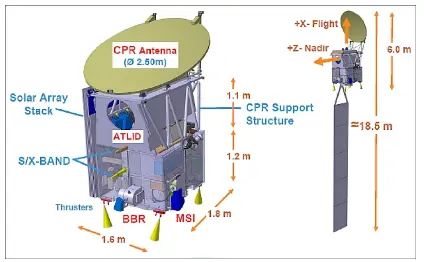
Objective:
- EarthCARE aims to offer comprehensive vertical profiles of clouds and aerosols within the Earth's atmosphere.
- It seeks to investigate the influence of these atmospheric elements on the Earth's radiation budget.
- By utilising high-resolution data, the mission aims to enhance the accuracy of climate models.
- Mission Specifications:
- Orbital Parameters: EarthCARE will orbit the Earth at an altitude of approximately 400 km (250 miles) in a sun-synchronous orbit.
- Orbit Characteristics: The orbit will have an altitude of 393.14 km, an inclination of 97.05°, a period of 92.5 minutes, and a repeat cycle of 25 days.
- EarthCARE will carry four instruments onboard:
- Atmospheric Lidar (ATLID): Provides vertical profiles of aerosols and thin clouds.
- Cloud Profiling Radar (CPR): Offers vertical profiles of thicker clouds.
- Multi-Spectral Imager (MSI): Acts as a multi-purpose imaging radiometer, delivering visible light and infrared radiation measurements of clouds and aerosols.
- Broad-Band Radiometer (BBR): Provides radiation measurements from the top of the atmosphere
Relationship between Clouds, Aerosol and and climate :
Clouds:
- The dominance of cooling or warming is determined by the cloud type.
- High, thin clouds trap more heat than they reflect sunlight, intensifying warming, whereas low, thick clouds promote cooling.
- Currently, low clouds are predominant, cooling the climate by counteracting greenhouse warming.
- However, as climate shifts, more high clouds and fewer low clouds are anticipated, reversing the overall effect to enhance warming.
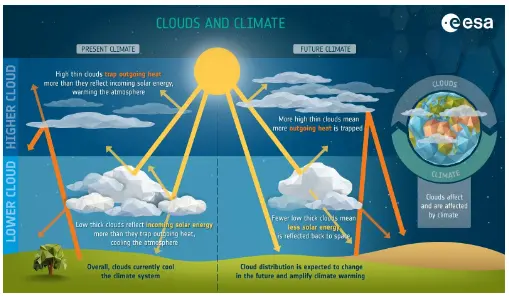
Aerosols:
- Aerosols and clouds share similarities in their direct effects, reflecting sunlight and absorbing and re-radiating infrared radiation. Increased aerosol concentration amplifies these direct effects.
- However, their primary climate influence stems from their indirect effects. Aerosols serve as cloud condensation nuclei, providing surfaces for water vapour to condense onto, forming cloud droplets.
- With abundant water vapour, higher aerosol levels lead to increased cloud formation and brighter cloud tops. This enhances sunlight reflection, strengthening the cooling effect.
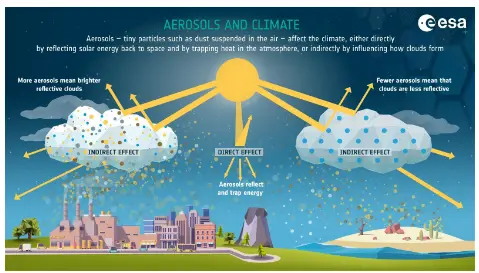
|
UPSC Civil Services Examination, Previous Year Question (PYQ) Mains: Q.1 What is the main task of India’s third mood mission which could not be achieved in its earlier mission? List the countries that have achieved this task. Introduce the subsystems in the spacecraft launched and explain the role of the ‘Virtual Launch Control Centre’ at the Vikram Sarabhai Space Centre which contributed to the successful launch from Sriharikota. (2023) Q.2 What is India’s plan to have its own space station and how will it benefit our space programme? (2019) Q.3 Discuss India’s achievements in the field of Space Science and Technology. How the application of this technology helped India in its socio-economic development? (2016) |
Source: (BBC)
IUCN Report on Mangrove Ecosystems
Context:
- A recent report from the International Union for Conservation of Nature (IUCN) warns that half of the world's mangrove ecosystems face the risk of collapse.
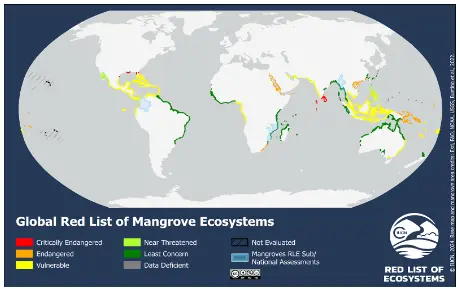
Key Findings of the Study on Mangrove Ecosystems
- Global Risk Assessment
- The research categorised the global mangrove ecosystems into 36 regions referred to as provinces, assessing the threats and risk of collapse in each region.
- More than 50% of global mangrove ecosystems face collapse risk, with almost 1 in 5 under severe threat.
- One-third of mangrove ecosystem provinces will suffer severely from sea-level rise, potentially submerging 25% of global mangrove areas within 50 years.
- Regional Vulnerability
- South Indian mangrove ecosystems, shared with Sri Lanka and the Maldives, are critically endangered.
- Mangrove ecosystems in the Bay of Bengal region (shared with Bangladesh) and the western coast (shared with Pakistan) are least concerned.
- Primary Threats
- Climate change is the primary threat to global mangrove ecosystems, impacting 33% of them.
- Other significant threats include deforestation, development, pollution, and dam construction.
- Cyclones, typhoons, hurricanes, and tropical storms are intensifying on certain coastlines, affecting mangroves.
- Global Impact
- Coasts along the Northwest Atlantic, North Indian Ocean, Red Sea, South China Sea, and Gulf of Aden will be significantly affected.
- Without increased conservation efforts, approximately 7,065 sq km more mangroves could be lost, and 23,672 sq km will be submerged by 2050.
The Status of Mangroves Cover in India:
- Approximately 40% of the world's mangrove cover is concentrated in South East Asia and South Asia, with India accounting for about 3% of the total mangrove cover in South Asia.
- India's mangrove cover has expanded by 54 sq km (1.10%) compared to the previous assessment, reaching a total of 4,975 sq km, which constitutes 0.15% of the country's total geographical area.
- West Bengal holds the largest portion of India's mangrove cover at 42.45%, followed by Gujarat at 23.66%, and Andaman & Nicobar Islands at 12.39%.
- The South 24 Parganas district of West Bengal alone contributes 41.85% of India's mangrove cover, encompassing the Sundarbans National Park.
- Gujarat has the most significant increase in mangrove cover, with an additional 37 sq km.
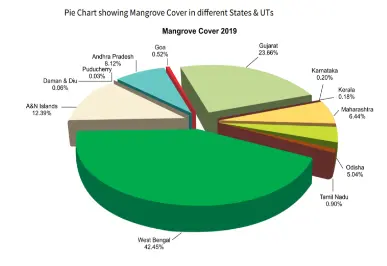
India's Conservation Initiatives:
- Coastal Regulation Zone (CRZ) Notification (2019) restricts activities detrimental to mangroves, such as waste dumping and industrial activities.
- Existing forest laws like the Indian Forest Act, 1927, and the Wildlife Protection Act, 1972, provide legal protection to mangroves.
- Other relevant acts like the Water (Prevention and Control of Pollution) Act, 1974, and the Maharashtra Tree (Felling) Act, 1972, further safeguard mangrove ecosystems.
- The Central Sector Scheme on 'Conservation and Management of Mangroves and Coral Reefs' offers financial assistance to coastal states and union territories for mangrove conservation.
- The Mangrove Initiative for Shoreline Habitats & Tangible Incomes (MISHTI) aims to promote and conserve mangroves, launched in the 2023-24 Union Budget.
Significance of Mangrove Ecosystem
- Biodiversity Conservation: Mangroves provide vital habitats for diverse plant and animal species, serving as breeding, nursery, and feeding grounds. Iconic species like the Royal Bengal tiger, Irrawaddy Dolphin, and Rhesus macaque thrive in areas such as the Sundarbans.
- Coastal Protection: Mangroves act as natural barriers, stabilise shorelines against erosion, storm surges, and tsunamis. Their robust root systems absorb and dissipate energy during hurricanes and cyclones, protecting inland areas and settlements.
- Carbon Sequestration: Mangroves efficiently absorb carbon dioxide from the atmosphere, storing it in their biomass and sediments, contributing to carbon sequestration efforts.
- Fisheries and Livelihoods: Mangroves provide crucial nursery areas for fish and shellfish, enhancing fishery productivity and supporting local livelihoods and food security.
- Water Quality Improvement: Mangroves serve as natural filters, removing pollutants and excess nutrients from coastal waters, preserving marine ecosystem health and maintaining coastal ecosystem balance.
- Tourism and Recreation: Mangroves offer recreational opportunities such as eco-tourism and nature-based activities like birdwatching and kayaking, promoting sustainable economic growth and fostering appreciation for mangrove conservation.
Challenges Faced by Mangrove Ecosystems
- Habitat Destruction and Fragmentation: Mangroves face clearance for agriculture, urbanisation, aquaculture, and infrastructure, leading to habitat loss and fragmentation, disrupting ecosystem functioning.
- Climate Change and Sea Level Rise: Rising sea levels and extreme weather events threaten mangroves, causing damage and loss.
- Pollution and Contamination: Agricultural runoff, industrial discharge, and improper waste disposal pollute mangrove habitats, harming flora and fauna.
- Lack of Integrated Management: Mangroves are often managed in isolation, neglecting their interconnectedness with adjacent ecosystems, necessitating integrated management approaches.
- Overfishing and Unsustainable Harvesting: Overfishing and unsustainable harvesting of resources like fish and timber diminish mangrove ecological and economic value.
- Invasive Species: Non-native species like the red mangrove compete with natives, altering mangrove ecosystems' structure and function.
Conservation Strategies:
- Implement stricter laws and enhance enforcement to prevent harmful activities.
- Establish mangrove adoption programs involving the public in conservation efforts.
- Invest in mangrove research and development for innovative conservation solutions.
- Empower local communities and ensure diverse species in restoration efforts for resilient mangrove ecosystems.
|
UPSC Civil Services Examination Previous Year Question (PYQ) Prelims Q:1 Which one of the following regions of India has a combination of mangrove forest, evergreen forest and deciduous forest? (2015) (a) North Coastal Andhra Pradesh (b) South-West Bengal (c) Southern Saurashtra (d) Andaman and Nicobar Islands Ans: (d) Mains Q:1 Discuss the causes of depletion of mangroves and explain their importance in maintaining coastal ecology. (2019) |
Global Food Policy Report 2024
Context:
- The International Food Policy Research Institute (IFPRI) recently released the Global Food Policy Report 2024 on "Food Systems for Healthy Diets & Nutrition."
- The report emphasises that a larger proportion of the population consumes unhealthy foods such as salty or fried snacks compared to nutritious options like vegetables and fruits.
Key highlights of Global food policy report 2024:
In South Asia:
- Cost Disparities in Food: Micronutrient-rich foods are costly, while cereals, fats and oils, and sugar are comparatively cheaper.
- High Cost Premium for Nutrient-Adequate Diets: South Asia exhibits the highest cost premium for nutrient-adequate diets. For instance, dark green leafy vegetables and vitamin A-rich foods are priced 22 times higher per calorie compared to starchy staples.
- Policy Priorities: Policies in South Asia prioritise starchy staples over diverse, healthy diets. Examples include price guarantees for rice, wheat, and sugarcane in India, and Sri Lanka's provision of subsidised fertiliser to rice farmers.
- Focus of Public Investments: Public investments predominantly target rice and wheat productivity, neglecting coarse grains and pulses, which are essential components of a diverse and nutritious diet
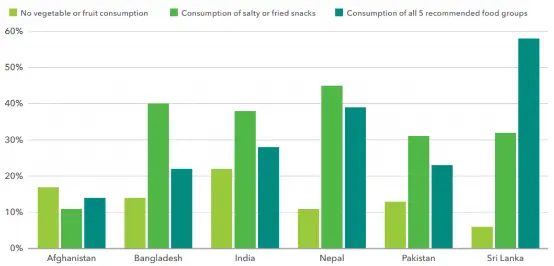
In India:
- Unhealthy Food Consumption: 38% of Indians consume unhealthy foods, while only 28% include all five recommended food groups (fruits, vegetables, proteins, grains/starch, and dairy) in their diet.
- Rise of Calorie-Dense, Nutrient-Poor Foods: Calorie-dense, nutrient-poor foods are increasingly prevalent, with snacks and prepared foods gaining prominence after cereals and milk.
- Increased Consumption of Processed Foods: Consumption of processed foods like chocolates, salty snacks, and beverages is on the rise, with packaged food spending doubling to reach 12% of household food budgets.
- Wealth Disparities in Food Spending: Wealthier households allocate more spending to processed foods, potentially reducing healthier food consumption among this demographic.
- Rise in Spending on Meals away from Home: Spending on meals outside the home surged from Rs 619 billion in 2015 to Rs 820 billion in 2019.
- Double Burden of Malnutrition: Many countries, including India, face a double burden of malnutrition, with issues of undernutrition, micronutrient deficiencies, overweight, and diet-related diseases prevalent.
- Affordability of Healthy Diets: Over two billion people worldwide, particularly in Africa and South Asia, cannot afford a healthy diet. Nearly 17% of Indians do not receive adequate dietary energy for a healthy life.

Impact:
- Malnutrition in India: Approximately 16.6% of India's population suffers from malnutrition due to poor diet. This figure has increased from 15.4% in 2011 to 16.6% in 2021.
- Micronutrient Deficiencies: More than half of children under five and two-thirds of adult women in India face micronutrient deficiencies, highlighting the widespread nature of the issue.
- Coexistence of Undernutrition and Overweight/Obesity: In South Asia, including India, Pakistan, and Afghanistan, high levels of undernutrition and micronutrient deficiencies coexist with the rising prevalence of overweight and obesity.
|
UPSC Civil Services Examination, Previous Year’s Question (PYQs) Q:1 Which of the following is/are the indicator/indicators used by IFPRI to compute the Global Hunger Index Report? (2016)
Select the correct answer using the code given below: (a) 1 only (c) 1, 2 and 3 (b) 2 and 3 only (d) 1 and 3 only Ans: (c) |
Source: DTE
LignoSat: World’s First Wooden Satellite
Context :
- Kyoto University and the logging company Sumitomo Forestry in Japan have developed the world’s first wooden satellite, LignoSat.

- LignoSat is scheduled to launch on a SpaceX rocket from the Kennedy Space Centre.
- The satellite is a mere 10 centimetres on each side and is crafted from magnolia wood, which was selected for its strength and workability.
- This wooden satellite would completely burn upon re-entry into Earth’s atmosphere.
- It will be delivered to the International Space Station (ISS), where it will be deployed for a series of tests to assess its strength and ability to withstand extreme temperature fluctuations.
Significance of LignoSat:
- Environmental Impact: Burns into ash on re-entry, leaving no harmful residues.
- Scientific Role: Equipped with sensors and cameras to study the behaviour of wood in space.
- Innovation: Demonstrates the potential of wood as a sustainable material for space exploration.
The Need For Such Satellites:
- Sustainability: Addresses the need for eco-friendly space exploration by using biodegradable materials, countering the threat of persistent non-biodegradable materials.
- Space Debris Management: Provides a solution to the growing issue of space debris by utilising biodegradable satellites to mitigate threats to spacecraft and the environment.
- Environmental Protection: Research emphasises the environmental impact of space debris, such as aluminium contributing to ozone depletion. This underscores the importance of sustainable satellite design to protect the Earth's atmosphere and ecosystems.
Source: (NDTV)
WIPO Treaty: Big win for India and Global South
Context:
- The recently concluded world intellectual property organisation (WIPO) treaty concerning Intellectual Property (IP), genetic resources (GRs), and Associated traditional knowledge (ATK) represents a substantial victory for global South nations, including India.
Key highlights of the WIPO Treaty:
- Protection of Biodiversity: Balancing the rights of biodiverse countries and traditional wisdom with the global Intellectual Property Rights (IPR) system.
- Inclusion of Traditional Knowledge: Acknowledging traditional knowledge systems within the global IP framework for the first time.
- Promotion of Inclusive Innovation: Recognizing the link between local communities, Genetic Resources (GRs), and Associated Traditional Knowledge (ATK), thereby fostering inclusive innovation.
- Disclosure Requirements: Mandating patent applicants to disclose the origin or source of genetic resources when their invention is based on such resources or associated traditional knowledge.
|
World Intellectual Property Organization (WIPO):
|
Significance for India and the Global South:
For the India:
- Recognition of Biodiversity : Acknowledges India as a mega biodiversity hotspot with rich traditional knowledge, marking the first inclusion of these systems into the global IP framework.
- Prevention of Misappropriation: Provides crucial protection to Indian Genetic Resources (GRs) and Associated Traditional Knowledge (ATK) by mandating disclosure obligations, preventing their misappropriation in countries lacking such laws.
- Combating False Claims: Addresses past instances of false claims on Indian herbs and products as foreign inventions, enabling India to contest such patent applications effectively.
- Establishment of Global Standards: Sets unprecedented standards within the IP system for countries rich in GRs and ATK, elevating India's status as a provider nation and ensuring fair recognition and protection globally.
For the Global South:
- Preservation of Traditional Knowledge: Recognizes the abundant traditional knowledge on medicinal plants, agriculture, and other domains within the Global South, safeguarding these invaluable heritage passed down through generations.
- Combatting Biopiracy: Combating biopiracy by instituting a legal framework to safeguard genetic resources and traditional knowledge from unauthorised commercial exploitation, ensuring equitable benefit-sharing and protection of indigenous rights.
Initiatives for Access and Benefit-sharing of GR and TK:
- Patents (Amendment) Act, 2005: Protects indigenous community rights by requiring patent applicants to disclose the origin of biological resources in their inventions.
- The Traditional Knowledge Digital Library (TKDL), established in 2001, addresses challenges in overturning patents on traditional remedies like turmeric and neem.
- Trademark Act, 1999: Founded on principles of distinguishability and prevention of confusion, trademarks differentiate goods and clarify product source.
- International initiatives: Convention on Biological Diversity, Nagoya Protocol, TRIPS agreement, International Treaty on Plant Genetic Resources for Food and Agriculture and Commission on Genetic Resources for Food and Agriculture.
- UNESCO's Local and Indigenous Knowledge Systems (LINKS): It is an interdisciplinary initiative that promotes indigenous and local knowledge and its meaningful inclusion in environmental policy and action.
|
UPSC Civil Services Examination, Previous Year Questions (PYQs) Prelims Q:1 With reference to the ‘National Intellectual Property Rights Policy’, consider the following statements: (2017)
Which of the above statements is/are correct? (a) 1 only (b) 2 only (c) Both 1 and 2 (d) Neither 1 nor 2 Ans: (c) Q:2 Consider the following statements: (2019)
Which of the statements given above is/are correct? (a) 1 and 3 only (b) 2 and 3 only (c) 3 only (d) 1, 2 and 3 Ans: (c) Mains Q:1 In a globalised world, Intellectual Property Rights assume significance and are a source of litigation. Broadly distinguish between the terms—Copyrights, Patents and Trade Secrets. (2014) |
JOURNEY TO 2047
Context:
- India aims to become a developed country by 2047, marking 100 years of independence.
- As of 2024, India’s per capita income is $2,500, far below the threshold for developed countries ($13,845).
- To achieve developed status, India needs an average annual real growth rate of 6-7%.
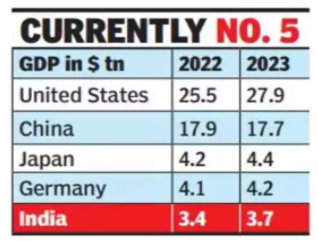
What is Vision 2047?
- Vision 2047 is a strategic document formulated by NITI Aayog, outlining India's long-term development goals.
- It aims to ensure that India avoids the middle-income trap, a situation where a country struggles to transition to a high-income economy due to rising costs and declining competitiveness.
- The document delineates action points and outcome goals for two periods: 2030 and the subsequent 17-year period leading up to 2047.
The Factors that may Contribute to India’s Economic Growth:
- Demographic Dividend: India's youthful population, over 600 million aged 18-35, drives economic growth. McKinsey projects annual growth of 1.3 million working-age individuals until 2030.
- Urbanisation: Rapid urban migration boosts productivity and consumption; by 2030, 40% of Indians will reside in cities.
- Infrastructure Development: Vital investments in roads, railways, ports, and airports drive economic growth; $1.4 trillion allocated via the National Infrastructure Pipeline.
- Digitalization and Technology Adoption: India's digital economy and tech adoption foster innovation; digital transactions surged to 4.73 billion in March 2022 from 3.76 billion in March 2021.
- Policy Reforms and Ease of Doing Business: Initiatives like GST and IBC streamline operations, attracting foreign investment and enhancing investor confidence.
- Global Integration and Trade: Trade volume surged to $1.23 trillion in 2020-21, up from $818 billion in 2015-16, bolstering economic growth.
- Investment in Human Capital: Education, healthcare, and skill development investments enhance productivity; Skill India aims to train 400 million by 2022.
- Sustainable Development Initiatives: Embracing sustainable practices fosters long-term growth; India's renewable energy sector surpassed 100 GW capacity in 2021, surpassing targets.
Future Prospects:
- GDP Growth Projections: India's GDP is forecasted to surpass Japan and Germany by 2030, with S&P estimating nominal GDP to soar from USD 3.4 trillion in 2022 to USD 7.3 trillion by 2030.
- Regional Economic Standing: This growth trajectory positions India as the second-largest economy in the Asia-Pacific region, indicative of its burgeoning economic stature.
- Export-Import Forecasts: NITI Aayog forecasts India's exports to reach USD 8.67 trillion by 2047, while imports are projected at USD 12.12 trillion, indicating a robust trade outlook.
- Socioeconomic Progress: Predictions from NITI Aayog indicate significant improvements in social indicators by 2047, including an increase in average life expectancy to 71.8 years and a rise in literacy rate to 89.8%.
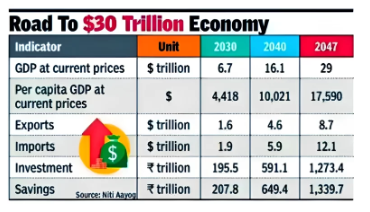
The Challenges before India’s 30 tn Dollar Economy Vision:
- Middle-Income Trap Concerns: There are concerns that India may face the middle-income trap, characterised by stagnation in economic growth after reaching a per capita income of USD 5,000-6,000, due to rising costs and declining competitiveness.
- Challenges of an Ageing Population: India's population, projected to peak at 1.64 billion in 2048, will subsequently decline, leading to challenges associated with an ageing population, including increased healthcare costs, pension liabilities, and labour shortages.
- Growth Rate Imperatives: Despite a commendable growth rate of 8%, sustaining economic growth necessitates a higher rate, with estimates suggesting India must grow at an annual average rate of 9.2% between 2030-2040 and 8.8% between 2040-2047, as per Niti Aayog projections.
- Rupee-Dollar Exchange Dynamics: India's GDP in dollar terms is intricately linked to the rupee-dollar exchange rate, influenced by factors like inflation, trade balance, capital flows, and monetary policy, adding complexity to economic projections.
- Geopolitical Considerations: India navigates a dynamic geopolitical landscape, marked by tensions with neighbouring countries like China and Pakistan, evolving relations with major powers like the US and Russia, impacting regional integration and stability.
- Revitalising Agriculture and Manufacturing: Addressing the productivity and competitiveness gaps in agriculture, employing over half the workforce but contributing only 17% to GDP, and rejuvenating the manufacturing sector, stagnant at a 15% GDP share, are imperative to generate employment and spur economic growth.
- Lower Labor Force Participation: India's labour force participation rate (LFPR) stood at 40.4% in 2022-2023, as per the Periodic Labour Force Survey (PLFS) Annual Report, significantly below the global average of 61.4%. Furthermore, India has witnessed a concerning trend of declining LFPR over the years, particularly among women.
Way forward to achieving Vision 2047:
- Harnessing Demographic Dividend: Efforts are necessary to enhance the skill sets of millions of our working-age youth nationwide, ensuring their readiness for evolving job markets and future employment opportunities.
- Increase Spending in Education Sector: India's allocation of government funds to the education sector has remained below 3.5% of GDP, lagging behind the global average of approximately 4.5% of GDP. Addressing this disparity is crucial for improving educational access and quality across the country.
- Inclusive Growth: It is imperative to promote greater participation of women in India's labour force and address wage disparities to foster inclusive economic growth.
- Unlocking Manufacturing Potential: India aims to bolster its manufacturing sector, with a target of expanding its contribution to the economy from the current 15% to 25%. Implementing initiatives like the Production Linked Incentive (PLI) scheme effectively will be instrumental in achieving this goal.
Conclusion:
Hence, vision 2047 outlines India's ambition to transition into a developed nation with a robust $30 trillion economy. Achieving this objective entails addressing obstacles like the middle-income trap and socioeconomic disparities, while capitalising on advantages such as a youthful demographic dividend and advancements in technology.
|
UPSC Civil Services Examination, Previous Year Questions (PYQs) Q1. Define potential GDP and explain its determinants. What are the factors that have been inhibiting India from realising its potential GDP? (2020) |
Source: (IE)
Practice Questions - Current Affairs 01-06-2024
Q1. Consider the following statements about Loss and Damages Fund :
1. It is an initiative of the Convention of Biological Diversity .
2. It is aimed to compensate for the losses incurred by communities, and ecosystems due to the impacts of climate change.
3. It is coordinated by World Resources Institute (WRI) and World Business Council for Sustainable Development (WBCSD)
Select the correct answer using the code given below:
1 and 2 only
2 only
2 and 3 only
1, 2 and 3
Q2. With reference to heat waves, consider the following statements :
1. Heat wave is considered if the maximum temperature of a station reaches at least 40°C or more for Plains and at least 30°C or more for Hilly regions.
2. India is the only country in Asia, recognizing the heat waves as natural disaster.
Select the correct answer using the code given below:
1 only
2 only
Both 1 and 2
Neither 1 nor 2
Q3. Consider the following
Dams : RIvers
1. Indira Sagar dam : Chambal
2. Mettur Dam : Krishna
3. Almatti dam : Cauvery
How many of the above pairs are correct ?
Only one
Only two
All three
None
Q4. Consider the following statements regarding Global Bio-Diversity Framework :
1. In this framework, countries have agreed to reduce government subsidies , harmful to biodiversity by 2025.
2. Individual countries have to take ownership of implementing GBF, aligning with their national circumstances and capacities.
Select the correct answer using the code given below:
1 only
2 only
Both 1 and 2
Neither 1 nor 2
Q5. With reference to Crop Diversification , consider the following statements :
1. Crop diversification is defined as the substitution of one or more agricultural products for another.
2. Crop diversification practice acts as a buffer against pests and diseases.
Select the incorrect answer using the code given below:
1 only
2 only
Both 1 and 2
Neither 1 nor 2
Q6. Bridge fuel , sometimes in news is related with :
Biofuels
Petroleum
Natural gas
Fuel Cells
Q7. National Disaster Relief Funds, some time in news is monitored by which among the following ministries :
Ministry of Home Affairs
Ministry of Agriculture
Ministry of Environment and Climate Change
Both “ a” and “ b “
Q8. With reference to Tundra Ecosystem , consider the following statements :
1. The tundra acts as a low carbon storage area due to slow decomposition rates in the environment.
2. Alpine Tundra is found at all latitudes in high altitude areas.
3. The summer growing season is just 50 to 60 days, when the sun shines up to 24 hours a day.
Select the correct answer using the code given below:
1 and 2 only
3 only
2 and 3 only
1, 2 and 3
Q9. With reference to recently released data on forest by Global Forest Watch , consider the following
1. Indonesia topped the ranking of tropical countries with the most primary forest losses.
2. In India, Assam had the maximum tree cover loss at 324,000 hectares.
3. Between 2001 and 2022, forests in India emerged as a net carbon sink .
How many of the above statements are correct ?
Only one
Only two
All three
None
Q10. Which of the following statements about India’s updated Nationally Determined Contribution (NDC) is not correct?
33 to 35% reduction in emissions intensity (or emissions per unit of GDP) from 2005 levels.
At least 40% of total electricity generation to come from non-fossil renewable sources.
An increase in forest cover to create an additional carbon sink of 2.5 to 3 billion tonnes of carbon dioxide equivalent.
To limit global warming to 1.5°C above pre- industrial levels.
Q11. Consider the following statements regarding Great Indian Bustards (GIBs):
Statement-I : The significant decline in the population of Great Indian Bustards (GIBs) is primarily due to frequent collisions with overhead power transmission lines.
Statement-II : Great Indian Bustards (GIBs) have lateral vision because their eyes are located on the sides of their heads, making it difficult for them to change their flight path when encountering a live wire.
Which one of the following is correct in respect of the above statements?
Both Statement-I and Statement-II are correct and Statement-II is the correct explanation for Statement I
Both Statement-I and Statement-II are correct and Statement-II is not the correct explanation for Statement-I
Statement-I is correct but Statement-II is incorrect
Statement-I is incorrect but Statement-II is correct
Q12. Consider the following statements regarding UNCLOS ( United Nations Convention on Law of Sea ) :
1. Marine areas are divided into three primary zones: the Territorial Sea, the Exclusive Economic Zone (EEZ), and the High Seas.
2. It has the mandate to resolve sea disputes such as fisheries and navigation .
3. It provides a different legal status to different maritime zones.
Select the correct answer using the code given below:
1 and 2 only
3 only
2 and 3 only
1, 2 and 3
Q13. Which of the following are the guiding principles of the “The Paris Pact for People and the Planet (4P)” initiative?
1. No country should be forced to choose between combating poverty and protecting the planet.
2. Nations should have the flexibility to follow different transition paths to achieve the Paris Agreement's goals.
3. We need a financial stimulus with increased resources to help vulnerable economies elevate their populations out of poverty.
4. Addressing global challenges will significantly depend on the expansion of public capital flows.
How many of the above statements are correct ?
Only one
Only two
All three
All Four
Q14. Consider the following statements regarding Caracal :
1. They are considered harmful to marine organisms .
2. They are the indicator species in the ecosystem
3. They are nocturnal animals.
It is listed in Schedule I of Wildlife protection Act , 1972
Only one
Only two
All three
All Four
Q15. Consider the following statements regarding Cicadas :
1. Cicadas are insects that spend the majority of their lives underground, emerging primarily to mate.
2. India and Bangladesh have the highest genetic diversity of cicadas in the world, followed by China.
Select the correct answer using the code given below:
1 only
2 only
Both 1 and 2
Neither 1 nor 2
Q16. Consider the following statements regarding Swell Waves:
1. It is the formation of long wavelength waves on the surface of the seas.
2. They occur under the influence of the local winds.
3. They sometimes even occur in enclosed or partially enclosed bodies of water
How many of the above statements are correct ?
Only one
Only two
All three
None
Q17. Consider the following statements regarding Artificial reefs :
1. These structures are created by using biorock technology and are placed on the seabed in either freshwater or saltwater environments.
2. These artificial reefs can boost tourism but cannot encourage the growth in fish population.
Select the correct answer using the code given below:
1 only
2 only
Both 1 and 2
Neither 1 nor 2
Q18. Consider the following statements:
Statement-I: India's effort to enhance early warning systems emphasizes the significance of international collaboration in tackling the increasing risks posed by natural disasters and climate change.
Statement-II: According to a report by the World Meteorological Organization (WMO), natural disasters have increased more than fivefold from 1970 to 2019, with water-related disasters being the most common worldwide.
Which one of the following is correct in respect of the above statements?
Both Statement-I and Statement-II are correct and Statement-II is the correct explanation for Statement I
Both Statement-I and Statement-II are correct and Statement-II is not the correct explanation for Statement-I
Statement-I is correct but Statement-II is incorrect
Statement-I is incorrect but Statement-II is correct
Q19. Consider the following statements regarding Unclassed Forests:
1. These forests are owned by both the government and private individuals or communities.
2. These forests are not officially notified under the Indian Forest Act, though the area has forest type vegetation.
Select the correct answer using the code given below:
1 only
2 only
Both 1 and 2
Neither 1 nor 2
Q20. With reference to the Protocol on Environmental Protection to the Antarctic Treaty, 1991, consider the following statements:
1. The protocol designates Antarctica as a "natural reserve dedicated to peace and science."
2. It establishes fundamental guidelines for human activities in Antarctica and entirely bans mineral resource activities.
Select the correct answer using the code given below:
1 only
2 only
Both 1 and 2
Neither 1 nor 2
Share the article
Edukemy’s Current Affairs Quiz is published with multiple choice questions for UPSC exams
MCQ
Get Latest Updates on Offers, Event dates, and free Mentorship sessions.

Get in touch with our Expert Academic Counsellors 👋
FAQs
UPSC Daily Current Affairs focuses on learning current events on a daily basis. An aspirant needs to study regular and updated information about current events, news, and relevant topics that are important for UPSC aspirants. It covers national and international affairs, government policies, socio-economic issues, science and technology advancements, and more.
UPSC Daily Current Affairs provides aspirants with a concise and comprehensive overview of the latest happenings and developments across various fields. It helps aspirants stay updated with current affairs and provides them with valuable insights and analysis, which are essential for answering questions in the UPSC examinations. It enhances their knowledge, analytical skills, and ability to connect current affairs with the UPSC syllabus.
UPSC Daily Current Affairs covers a wide range of topics, including politics, economics, science and technology, environment, social issues, governance, international relations, and more. It offers news summaries, in-depth analyses, editorials, opinion pieces, and relevant study materials. It also provides practice questions and quizzes to help aspirants test their understanding of current affairs.
Edukemy's UPSC Daily Current Affairs can be accessed through:
- UPSC Daily Current Affairs can be accessed through Current Affairs tab at the top of the Main Page of Edukemy.
- Edukemy Mobile app: The Daily Current Affairs can also be access through Edukemy Mobile App.
- Social media: Follow Edukemy’s official social media accounts or pages that provide UPSC Daily Current Affairs updates, including Facebook, Twitter, or Telegram channels.

